“The Other World War 2”: Wargaming in the Pacific (Part Four)
August 25, 2014 by crew
The Invasion of Warrenai
Thus far in this article series on Wargaming in the Pacific, we’ve discussed some of the key arenas of the Pacific War and sketched out an example wargame reflecting jungle campaigns like those fought in Burma, New Guinea, and Guadalcanal. Now, in the final article of this series, we switch focus back to the Central Pacific, and once again set up an example campaign to show how designers and wargamers can approach this unusual setting.
Setting the Scene
When the American novelist Norman Mailer wrote The Naked and the Dead (based on his experience in the Pacific War), he created the fictional island of Anopopei so he could tell his story unrestricted by military history. We’ll follow the same approach, and set our Central Pacific campaign at the fictitious “Warrenai Archipelago.”
The Central Pacific was a unique campaign in World War II, ranging across thousands of miles of empty ocean only to focus incredible violence and bloodshed over tiny atolls sometimes no bigger than a large shopping mall. In order to make our example as applicable as possible, we’ll make the Warrenai Archipelago typical of the island battlegrounds of the Central Pacific, a secluded tropical paradise largely unheard of before the war. They are arranged in a general ring shape, the result of coral building up along the caldera ring of an undersea volcano. The islands are formed around Lloyd’s Lagoon, which in some places is a perfect harbour, in other places is a treacherous maze of jagged coral reefs. The main island is Warrenai, only four kilometres long, just big enough for an airfield where the Americans want to base B-25 medium bombers for operations against the Philippines and Formosa.
Other islands in the archipelago include Justin Isle, Gianna Island, and Dawn Atoll, some of which house small Japanese airfields and a seaplane base. Formerly an undefended British possession, the Warrenai Archipelago was quickly taken by the Japanese when war broke out in December 1941, and for over two years have been fortified by a Japanese garrison of about 3,500 men of the Special Naval Landing Force (SNLF). Made largely of coral, these islands are natural fortresses, and any caves, bunkers, or pillboxes the Japanese have drilled into this rock are sure to be extremely resilient.
Our first decision, as always, is to determine the best scope or gaming system to use. For a Central Pacific campaign this is especially important because some scales of wargaming just don’t work (large tactical games like Panzer Leader or even Flames of War will probably devolve into brutal and hyper-dense shoving matches). Also, Central Pacific games were much more intricate examples of joint sea-air-land operations, making multiple game systems almost a given.
Design thinking for a Central Pacific game should always start at sea. If the invaders don’t control the air, they don’t control the sea and thus can’t approach the island with a fleet of slow, unarmed troop transports. Games like Clash of Arms’ “Command at Sea” offer an in-depth look at tactical World War II naval and carrier combat. Meanwhile, if you want to go old school, Seekrieg is an excellent game with rich detail, not to mention a great site for support. Another choice is Axis & Allies: War at Sea by Wizards of the Coast. This game is quick, fun, and customizable, and the pre-paint miniatures are relatively inexpensive. This makes it a great start for Pacific wargames.
A typical Central Pacific campaign usually started when the Americans began bombing and shelling the target island. But only when the invasion fleet arrived at the island could the Japanese Navy be sure of the target and react accordingly. This would spark a naval battle 4-10 days after first landings (Savo Island, Philippine Sea, and Leyte Gulf are good examples). Meanwhile, furious land combat on the actual island was already in full swing.
To accommodate this, let’s envision our Warrenai Archipelago game based on one-day operational turns, with tactical combat resolved via Axis & Allies: War at Sea for naval combat, and Bolt Action or Axis & Allies Miniatures for ground combat.
The Conflict Begins
Days 1-5: The American Third Fleet (Admiral William F. “Bull” Halsey) enters the operational map and begins carrier airstrikes against Japanese positions on Warrenai, Justin’s Isle, and Gianna Island. They can also use part of their battleship, cruiser, and destroyer screen to commence shore bombardment. These islands are so small that every inch should be in range of these guns, but everything is also fortified, well-hidden or underground. The Japanese also get a submarine attack roll each day, as well as a ground-based airstrike roll. These can either attack the Third Fleet or the actual invasion force still held off the board. This roll should be pretty easy, but be adversely modified by the amount of escorting vessels and carrier air power the American player has set aside for defence (thus reducing available firepower against Japanese ground targets).
More ominously, the American player should also allocate warships to protect his landing ships against the Japanese carrier fleet, which also gets to make a roll each day to arrive on the operational map. This roll should become steadily easier with each successive day, and should come after the American decision whether to land his troops that day. Thus, the American is forced to make this decision with incomplete information. If the Japanese fleet makes its entry check before the invasion force is landed, it should have the option to go after the invasion fleet, hence the importance of escorting American warships.
Once the Japanese fleet makes its entry roll, the Americans should get a spotting check to see how close they get before detection. This roll should be difficult, but made easier depending on how much airpower, picket ships, and scout submarines the Americans have allocated to a long-range screen. Again, this all comes out of Third Fleet’s force pool, forcing the Americans to make tough decisions in resource management.
So isn’t it safer for the Americans to land their invasion force right away? This is essentially what they did at Tarawa, which nearly ended in disaster when landing craft were hung up on uncharted reefs. After that, elite Underwater Demolition Teams (UDTs) were deployed beforehand to find or blast open gaps in reefs, Japanese minefields, and other obstacles. Perhaps the Americans make a roll each day for UDTs, and for each roll that succeeds, the invasion force gets a +1 on whatever navigation checks they have to make on D-Day. The longer the Americans wait, the more thorough this preparation and the easier the assault will be (they’re also softening Japanese defences with bombers and naval gunfire, remember). But they also run the risk of that Japanese carrier strike group finding their invasion force still out at sea. Again, it’s all about decisions.
Day 6: The Japanese Navy shows up and begins what history will record as the Battle of Dawn’s Atoll. Even while this battle is still in progress via A&A War at Sea, the Americans finally send their invasion fleet into Lloyd’s Lagoon and start the invasion of Warrenai. Two Marine regiments (about 5,000 men) are sent in with the first wave at Warrenai, while one battalion (600 men) is detailed to clear the Japanese seaplane base at Gianna Island and two battalions (1200-1500 men) is sent to occupy the small airstrip on Justin’s Isle.
Day 7: The Americans win the Battle of Dawn’s Atoll, although heavy damage to several key ships will force them to stretch naval resources more thinly, slowing ground bombardment and resupply operations. Meanwhile, things on the ground are equally hard. Although Bolt Action games have resolved the action on Justin Isle and Gianna Island, the fighting on Warrenai itself is horrendous.
Elite Japanese marines of the SNLF are honeycombed into the coral rock, compelling the American player to hammer his way through a series of bloody, close-range infantry fights. Flamethrowing Shermans are brought in, while Marine engineers attack bunkers and pillboxes with Bangalore torpedoes, flamethrowers, and satchel charges. Point-blank shelling by American battleships is sometimes the only way to soften Japanese defences.
Some of the toughest fighting is on the commanding mountain on the far eastern end of Warrenai, known as Pointe Romain (named for a famous French painter who used to find inspiration here, particularly well-known for his very small . . . almost miniature . . . work). Possession of such high ground is vital (Iwo Jima’s Mount Suribachi is a great example), since the Japanese will need it to direct artillery batteries from all over the island. If the Americans can take it, the heaviest Japanese weapons are effectively blinded.
Come what may, the Americans will almost certainly win the battle. It’s all a question of time and casualties, and it’s in these victory conditions that a balanced GAME can be leveraged out of an imbalanced BATTLE. Although they eventually ended in American victory, historical battles like Peleliu, Luzon, and Tarawa are often criticized because incomplete planning, reconnaissance, and command preparation resulted in excessive losses or protracted time-frames that impacted subsequent operations of the grand strategy. In gaming terms, the Japanese player would have “won” those games.
So who wins at Warrenai? That’s up to the gamers, of course! Meanwhile, I hope we’ve sparked some ideas for Pacific gaming, or at least some discussion in the comments below.
If you would like to write an article for Beasts of War then please contact me at [email protected] for more information!
"A typical Central Pacific campaign usually started when the Americans began bombing and shelling the target island..."
Supported by (Turn Off)
Supported by (Turn Off)
"So who wins at Warrenai? That’s up to the gamers, of course!"
Supported by (Turn Off)































![How To Paint Moonstone’s Nanny | Goblin King Games [7 Days Early Access]](https://images.beastsofwar.com/2024/12/3CU-Gobin-King-Games-Moonstone-Shades-Nanny-coverimage-225-127.jpg)









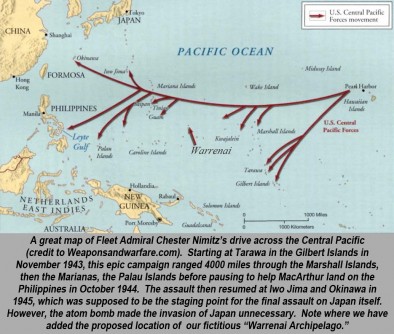
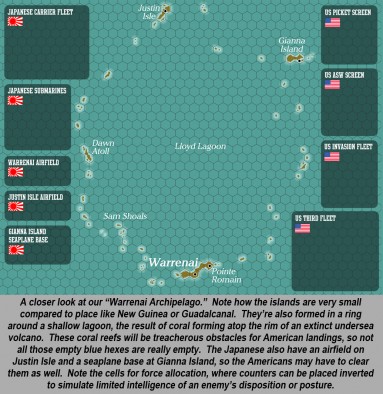
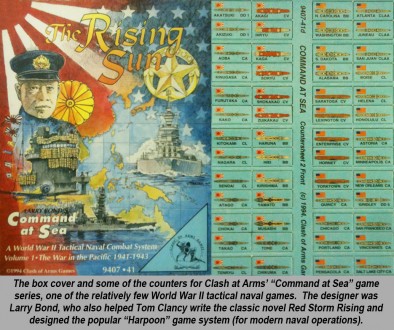
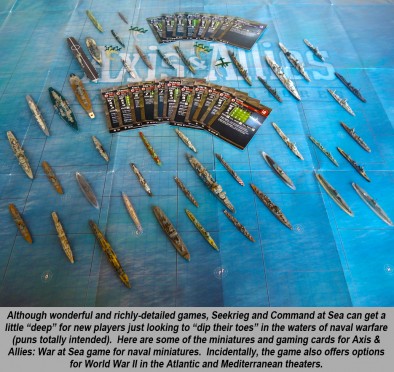

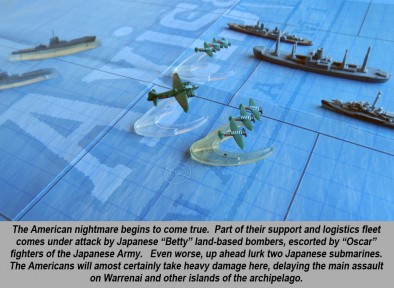
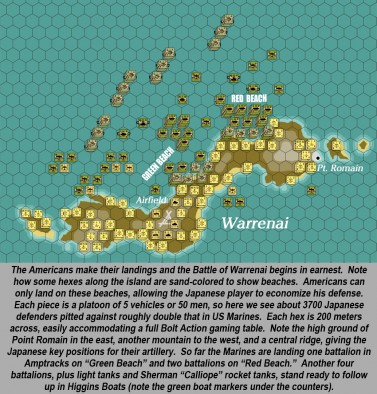
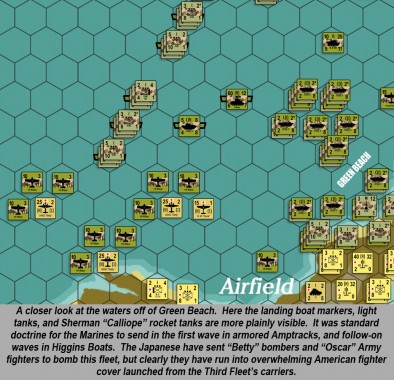
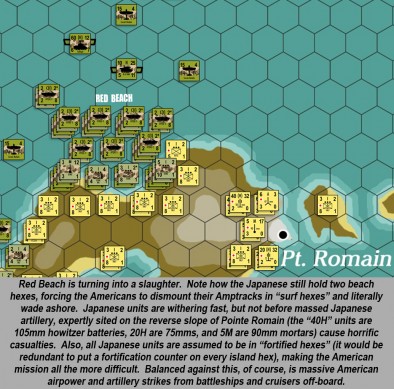
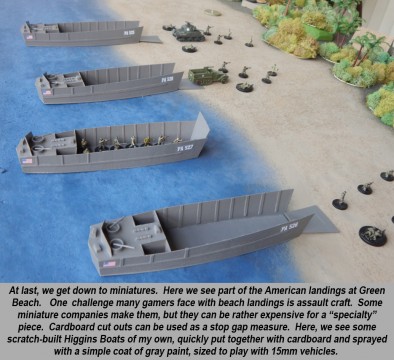
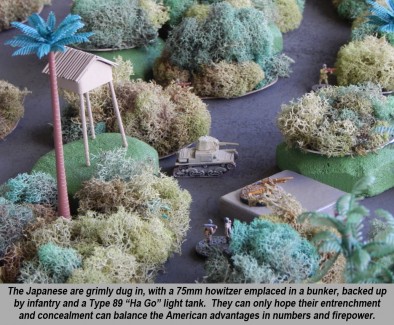
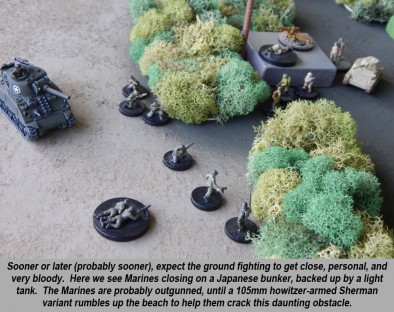
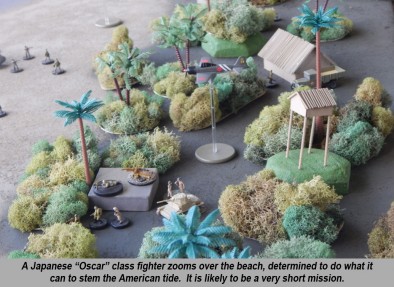
































Once again, great job, Jim! Very thorough and in-depth analysis, and ample opportunities for game play. Also, nice work on the scratch-built landing craft!
Now you need to write an article on ‘tank origami’ for the Japanese side, so they can manufacture a score of them to stem the tide of the American onslaught :-).
Thanks, @cpauls1 . 🙂 I originally only started building them very quickly with no detail (just to take the pictures for this article). But they started going together pretty well, and before I knew it I was adding more and more detail, paint, markings, etc. I still want to go back and paint the winches, the .30 cal MGs, etc. I might also go into my “bitz box” and grab some old leftover tanks commanders and such, and put them in the starboard side “pilot station.” The boats are sized to fit two 15mm Sherman tanks (I honestly don’t know… Read more »
Very good article. It is good to see the PTO getting some attention. I also like the Axis and Allies Naval miniatures. It is nice to see them getting a little press.
You know, the more I think about this, the more I like the idea of a campaign centered on a fictional atoll, with Panzer Leader being the game of choice for resolving battles at the tactical level. I’m not sure about the sea battles… I don’t have much experience with those game systems, but I’m sure one of the beefier ones mentioned, rules wise, would suit my needs. I would be more inclined, if I’m playing something fictitious anyway, to start with equal battle groups, in terms of points, with each side in possession of several islands, 1944 technical goodies… Read more »
Thanks, @cpauls1 . To draw these maps I use Photoshop with a Bamboo/Wacom stylus pad. The nice thing is that you can download hex grid ,pngs from Google Images or the like, and then transpose that over your map file in Photoshop. Since these graphics elements are still stored as separate layers within the file, you can still draw on the map “underneath” the hex grid. This helps make sure you terrain lines up with the hex grid where it’s important for game clarity (rivers, coastlines, elevation markers, etc). My brother and I once ran a faithful recreation of Tawara… Read more »
Thanks, @tibour . The A&A naval warfare minis are a great little “gateway” game into the basics of WW2 naval warfare. Sure, other games are more realistic and detailed, but perhaps a little too steep of an **initial** investment and learning curve for gamers who just want to experiment occasionally in naval or PTO gaming. 🙂 The nice thing about A&A preparing naval minis is that the scale is very close to the scale in games like Seekrieg, so even if players later “graduate” out of A&A War at Sea, you can still use the minis in other games. The… Read more »
A nice end to the run @oriskany you mist a chance their you could have replaced Yorktown with Oriskany? She was sunk at midway? Is not hazardous to land troops from inside the atoll is not better to land from seaward side rougher seas but less coral to contend will plus open water behind the fleet not enemy occupied islands with possible enemy fire. I loved the landing craft when I enlarged the picture I seriously though they were plastic models.
Thanks, @zorg . Yes, Yorktown was sunk at Midway, but once they started building the new Essex-class carriers later, they named one the Yorktown as well and this second ship survived the war. There was also an Essex-class carrier named the Oriskany, CV-34. She was completed too late to serve in World War II but fought in Korea and Vietnam. They recently sank her off the Florida coast, where she’ll form the basis of the largest man-made coral reef (or something like that??) http://en.wikipedia.org/wiki/USS_Oriskany_(CV-34) Maybe you’re right, though. I should change my BoW handle to Yorktown . . . maybe… Read more »
Yes but the Yorktown isn’t in the Guinness book of records as the world’s biggest artificial reef. LOL I saw the program about the sinking they panicked as she started to sink that she would turn turtle. So what’s next then?
Indeed, the Essex-class Yorktown I think wound up as a museum or landmark somewhere. A better “retirement” than the Oriskany getting sunk somewhere off of Pensacola. 😀 Then again, a lot of BoW folks live in the UK, so changing my screen name to “Yorktown” might not be too slick. 🙂
How many museums have the money & space to park a carrier look at the UK the only major war ship from WWII is the cruiser Belfast.
Well, its not the same war, obviously . . . but doesn’t the UK still have Lord Nelson’s HMS Victory somewhere as a museum? I’ll admit, the US mas many more. I’ve been aboard USS Intrepid in New York, USS Midway in San Diego, and USS ??? (can’t remember the name of the Gato Class submarine) in Hackensack, NJ. Battleship USS Alabama is in Mobile Bay, USS Yorktown is somewhere, battleship USS Missouri is being set up in Pearl Harbor (right next to USS Arizona memorial, fitting to see the very beginning and very end of US involvement in WW2… Read more »
@oriskany yes had a quick look on Wiki to see what other ships are still about. the HMS Victor (Ship of the line) also the HMS Warrior (Ironclad) & HMS M33 (monitor) at Portsmouth HMS Cavalier (Destroyer) HMS Ocelot (Sub) HMS Gannet (sloop) Chatham Kent HMS Alliance (Sub) Gosport RN sub Museum HMS Caroline (WWI light Cruiser) Belfast HMS Unicorn (rigged Frigate) half restored Dundee HMS LCT-7074 (landing craft) Birkenhead sunk at moorings’ and of Corse HMS Belfast (Light Cruiser) London. Probably other ships about but that’s the official list of major war ships not a lot about now. Closest… Read more »
Awesome. 🙂 HMS Belfast would be fun to visit one of these days, and of course HMS Victory. You can’t get much more prestigious than that. I guess USS Missouri comes **close** (final surrender for WW2 signed on her deck), but this was a ceremony, not a battle. Missouri saw plenty of combat, of course, but nothing as pivotal as Trafalgar. 🙂
@oriskany
The scary thing about Trafalgar was very few of the Spanish ships that survived the battle was got home most of the ships ended up shipwrecked up & down the cost of Britain and Ireland with the crew being killed by locales for the valuables onboard.
Okay, just asking here, @zorg . . . Are we talking about Spanish Armada (1588) as opposed to Trafalgar (1805)? I read briefly about this with the Spanish Armada, but for all I know the same thing happened with Trafalgar. 🙂
Your write wrong war that was the Armada I was thinking about. You’re correct the fleet was hit by a storm with several of the damaged ships sinking many of them captured Spanish which was very disappointing for the British crews because they got a percentage of the ships value added to Thayer wage.
Yeah, @zorg . That campaign really didn’t end well for the Spanish Armada. 🙂 First, a lot were burned up by the English fire ships. Then, the weather blew them to the wrong side of the ocean 🙂 Then a lot of them starved or died from disease. Then a lot of them survived shipwrecks only to be beaten to death by Irishmen, Englishmen, and Scotsmen (as you noted before). Ever get the feeling that you just shouldn’t gotten out of bed in the morning? 🙂
@oriskany how do we know their bed’s weren’t lying on the same beach?
Excellent series of articles, thanks very much.
Thanks, @gremlin . 🙂
Well done man. Thanks for your hard work.
Thanks, @ghostbear . Appreciate the compliment! 😀
Thanks fo rall the great articles, maps and min-photos. Everything looks awesome. I like the M4/105 aka “Angel of Death” Your beach and jungle terrain is fantastic and the Higgins Boats kick ass.
And yeah, I’ll reiterate. Panzer Leader is accurate in the Pacific. But choose your battle carefully.
Thanks, @amphibiousmonster . Marines used a lot of M4/105 support Shermans, Calliopes rocket Shermans, and “Zippo” flamethrowing Shermans . . . basically anything that was antipersonnel. They sure didn’t have much need for Easy Eights and such, not with those Ha Gos and Chi Has they were fighting in “tank” battles. 🙂 Thanks for the feedback on the terrain, maps, and Higgins Boats. Yep, larger tactical games like Panzer Leader and Flames of War I think work better for larger battles, which there are in the Pacific, but you’re right . . . you have to pick ’em. (or like… Read more »
Personally, I find the early war more interesting but it’s good to see this often forgotten theatre of the war get some attention.
Though the SNLF were not really an elite formation. They were just sailors with basic infantry training, yet another testament to the Japanese inter-service rivalry undermining their war effort.
Thanks for the input, @maxxon . I agree that early war is indeed a lot of fun (and usually more interesting than late war, at least European late war . . . from a gaming perspective) , as we recently tried at our gaming club:
http://www.beastsofwar.com/groups/historical-games/forum/topic/early-war-armor-action-french-vs-germans/
“. . . I’m sure there are more.”
The New Jersey is tied up down in Camden I think. I saw it from the back row of the Camden Ampitheatre waiting for Dave Matthews to come on.
That being said… I could’ve halucinated the whole thing…
Nope, no hallucination. 🙂 I looked it up and you were correct. The site for the USS New Jersey museum (BB-62) is linked below.
http://www.battleshipnewjersey.org/
Hmm … watch Dave Matthews or walk the decks of the USS New Jersey … that would have been a tough call (just kidding … I’m sure the museum was closed right then).
Yes would love to go on a big ship like the Belfast or New Jersey didn’t know they were six of the Iowa class built.
The confusion might be my fault, but we only had four Iowas:
BB-61 Iowa
BB-62 New Jersey
BB-63 Missouri
BB-64 Wisconsin
Often confused with the preceding South Dakota class:
BB-57 South Dakota
BB-58 Indiana
BB-59 Massachusetts
BB-60 Alabama (I probably should have said this wasn’t an Iowa in my previous post 🙂 )
and the preceding North Carolina Class
BB-55 North Carolina
BB-56 Washington
There was another class planned for after the Iowas (perhaps in response to reports of the Japanese building the Yamato-class), but of course these were never constructed.
@oriskany the official records are Iona 61 New Jersey 62 Missouri 63 Wisconsin 64 Illinois 65 Kentucky 66.
Illinois BB-65 Philadelphia Navy Yard laid Sep 1940 cancelled Aug 1945
Kentucky BB-66/BBG-1 Norfolk Navy Yard laid Sep 1940 Broken up 1959
Both were going to be upgraded to be the first two of the Montana class Battleships the only part of the Kentucky still around is the nose which was removed to be welded onto the Wisconsin after colliding into the Destroyer Eaton.
Now THAT is pretty cool, @zorg . Knew about that Montanas (I think they were supposed to have a fourth turret of x3 16″ guns, but did NOT know another two Iowas were planned. 🙂
See that? On Beasts on War you learn something new every day. 😀
I think they were cancelled because the final design would not fit the panama cannel? @oriskany
I know all our ships of the period were limited to beams of 108′ because of the Canal, although I have very recently learned that not all American WW2 ships observed this limitation. The Tennessee and California (their miniatures are featured above) were “sunk” at Pearl Harbor but when they were raised, repaired, and modernized, wound up being over 108 feet wide and so could not reasonably participate in both Pacific and Atlantic wars (unlike the Nevada, run aground at Pearl Harbor but still helped bombard Pacific islands as well as Normandy I believe). I think the Montanas were cancelled… Read more »
@oriskany you could be correct after all the pacific is a much bigger area plus the number of ships the navy were building a few ships limited to the long route would not make a big difference plus they would be needing the slipways for the carriers.
The Yamato would have loved to have seen something that big in the flesh.
I think many of the Japanese carriers were retro fitted cruisers and the like anyway? Weren’t the kamikaze (ordered) to go for the carriers?
That’s right, @zorg . The Japanese flagship Akagi and also Kaga were started as battlecruisers (“fast” battleships), as were the American Lexington, Saratoga, and I think some British pre-war carriers as well. The reason was the Washington Naval Conference of 1928 (29?) Basically. the big naval powers were getting out of hand with their battleship construction (a big factor leading to World War I), so they got together and agreed on how many battleships each nation could have and how much they could weigh. Well, many nations already had battleships and battlecruisers under construction that would now be in violation… Read more »
Yes @oriskany the first trials were ramps built along a heavy turret’s gun barrels.
Not just navy ships were converted some of the escort carriers in the Atlantic were cargo ships conversions to spot U-boats & fight condor aircraft closing the gap between the US & UK.
That’s right, @zorg . I couldn’t remember the name of the ship, so found this article about HMS Hibernia with the seaplane type ramps launched off the top of gun turrets.
http://en.wikipedia.org/wiki/HMS_Hibernia_(1905)
I would still call ships like HMS Furious and HMS Argus the first “real” carriers, though.
And yes, the first “true” American carrier was USS Langley, I converted cattle ship I believe. I’m pretty sure Japan’s IJN Hosho was the first ship actually designed and built as a carrier from the start
You could never do that today the health & safety paper work would sink the boat LOL.
Awesome article and maps. I like how they start out hi-level, then zoom in gradually until we’re looking at individual miniatures and tanks! Great job! 😀
Thanks, @gladesrunner ! 🙂
@oriskany another well written article that gives a lot of ideas and insight into planning a game set in the Pacific Theatre of Operations. I like the idea of implementing a complex approach to the game including the air/sea/land warfare. It would be interesting to see the American force really weakened prior to the landing operations. The Japanese player could actually win.
Thanks, @yavasa . I agree that a weakened American force (possibly through Japanese naval interdiction) would have made for very interesting problems during subsequent American landing and ground warfare operations. “Unfortunately” — and please understand, those are HUGE hypothetical “wargamer quotations” around the word “unfortunately” — that never really happened in the Central Pacific, which is why I thought a fictitious invasion would be more interesting to write about. It happened once at Guadalcanal (South Pacific), where elements of 1st Marine Division landed and were almost immediately stranded without supplies or reinforcements after a Japanese cruiser squadron kicked the holy… Read more »
@oriskany I know what you mean and just as you I am glad that the situation I have mentioned did not happen except Guadalcanal. I was just looking from the gamers point of view. The situation that I was referring to would have to be a resultant of the air/naval phase of the operation as you have mentioned that might have happen more often then one would expect if the Japanese player would a cunning opponent. On a side note at first I was surprised by your reaction to my previous post since we are talking strictly from an armchair… Read more »
No worries, @yavasa , that clarification in my last post was totally aimed at myself. I was typing away and wrote: “unfortunately, the American fleet was never weakened to a point where their invasion failed, etc . . .” And I said to myself: “Hmm . . . let me clear that up.” 🙂 I agree completely. A savvy (and lucky) Japanese player could very easily score some heavy blows against the US invasion fleet, thus forcing the American to postpone or cancel his invasion, or land with far less forces than he originally intended. Although our example game is… Read more »
Carriers may be more practical but battleships are soooo much cooler!!!!
Well have to wait until inter-stellar warfare becomes a thing I guess. Or play “Darkstar”
Battleships & Tanks
Carriers …
can’t fire …
broadsides!!
End of debate. 🙂
yup
I guess the one difference is that when people said battleships were obsolete and they were. People have been saying tanks were obsolete since 1920 … And they’re still rockin’. 🙂
A battleship is to easy to kill to day tanks have changed to keep up with technology better.
So are battleships! They’ve been dragged out of mothballs for every major U.S. engagement involving naval forces… and for good reason. What’s old is new again, as the saying goes, and what battleships possess is something no other ship has, and something that there is no counter for: a 16-inch projectile. While the range is only 20 miles, far less than what modern weapons like the harpoon are capable of, there is no counter for what is essentially a mid-sized sedan (up to 2700 lbs.) screaming through the sky at 2500 fps. And with the new generation ballistic computers you… Read more »
Hey, @cpauls1 is back! I agree with just about everything in your post, in fact I wish the Secretary of the Navy and the Armed Forces Appropriations Committee had seen things your way in the mid and late 90s. I honestly think, however, the day of the battleship has finally passed. Yes, the four Iowa class battleships were brought back into service, at least one or two of them each time for Korea, Vietnam, and even the 1991 Gulf War (USS Wisconsin and Missouri, last time these ships fired in anger I think – 16 inch shells and Tomahawk cruise… Read more »
So sad. Back in the 80’s and 90’s us poor Intelligence saps were tri-service, meaning that even if you were in the army, you had to be prepared to be attached to naval or air force contingents sent abroad. When doing the ‘navy thing’ briefly and comparing weapon and fleet capabilities the refurbished battleships always stood out as being one of the most versatile, capable, and downright dangerous ships in the U.S. inventory.
Sad that they have come to that. I thought they had just been decommissioned and mothballed until the next crisis.
I remind myself that they had a good long life (60 years, four wars) and are now all a cherished part of our naval heritage as museums. I know that sounds like emotionalism, but if you want to get cold and analytical, an Iowa battleship can’t really stand up to a Nimitz class carrier strike group in any real category of operational flexibility or capability. I realize that’s totally an apples-oranges comparison ($10B for a Nimitz class carrier, refurbishing an Iowa $450M, although this is 1980s money). But in a time when our first nuclear carrier, USS Enterprise, is being… Read more »
@oriskany in the US the last remaining Dreadnought (in the world) is still used for training cadets even though she is a open museum so battleships can still play a part today don’t you think.
I would say battleships still has the trump card when it comes to presence because they can fire nine shells twenty plus miles that can’t be stopped once fired by anything.
I totally agree @zorg . . . battleships have that “awe” factor. Although I’ve seen Nimitz class carriers at sea and watched them launch a dozen 60,000 pound Tomcats . . . EACH loaded with enough ordinance to flatten half a city hundreds of miles away. That was pretty impressive, too. And trust me, these bad boys can be just as unstoppable as a 16″ shell, at least by any enemies we’re likely to face in the near future.
I know its considered silly to reply to your own post, but i wanted to clarify my position because it sounds like I’m “getting down” on battleships and that isn’t the case at all. The best comparison I can make is to say battleships are to the US Navy like minis are often to us gamers. 🙂 How many times have we seen something on Beasts of War and, fully beset with shiny syndrome, said “Ooo! I have to have that!” But then we ask ourselves a series of questions. How much does it cost? What game would I use… Read more »
@oriskany I think you’re correct all navy’s around the world were hit with major budget cuts after the war so they had to cut something. And since battleships are very expensive to run plus they could have 4 or 5 ships with the crew numbers of one battleship for less money to do 99.9% of the ships tasks in more than one place at a time. have a look at the web sites I checked out about what happened to some of the surviving warships after the war to get a bit of a perspective of their future’s http://en.wikipedia.org/wiki/USS_Texas_(BB-35) Bikini… Read more »
I think it’s anytime you put too many links in a post, the automated BoW web management software thinks you may be spamming. Happened to me once. It was especially weird in my case because I was in a semi-heated thread making an “unpopular” point, and since it was the first time this had happened to me I thought maybe I’d said something “too far” for the site, But it was no worries, I let the BoW team know and they sorted it quickly.
Yes they emailed me to say they were fixing the post and to put a max of two web links to prevent hang-ups like that again. LOL @oriskany
@oriskany the life of a old war ship was not a good one in most cases the lucky ones / famous went to museums but most became targets for all the new weapons made to kill them to help kill them quicker but the really unlucky ones were sent to Bikini Atoll for the ultimate weapons test This is the abbreviated reply because the original is still in limbo Some of the Shipwrecks at bikini Atoll Shipwrecks in the lagoon include: USS Saratoga (CV-3) – aircraft carrier USS Arkansas (BB-33) – battleship USS Gilliam (APA-57) – attack transport USS Carlisle (APA-69) – attack transport USS Lamson (DD-367) – destroyer USS Anderson (DD-411)… Read more »
I didn’t have all the other names, but I did know about the Nagato and especially the Saratoga. You know how it is, the big ships get all the attention. 🙂 I was always especially “disappointed” about the Saratoga’s end. Sister ship of the Lexington (sunk at Coral Sea), she was the oldest “real” carrier we had (discounting USS Langley, CV-1). Anyway, the Saratoga sadly never did very much in WW2, always damaged or needing repair or broken down or training an air group, etc, At least not as much as her Hornet class or Essex class companions. But at… Read more »
Hears some more ships @oriskany
Fifteen ships of the Royal Navy have been named HMS Enterprise (or HMS Enterprize) while another was planned:
HMS Enterprise was a 24-gun sixth rate, previously the French frigate L’Entreprise, captured in May 1705. She was wrecked in October 1707. Was the first to be called Enterprise for the English / British navy?
P.s. did you see below about a possible alternative game scenario using WWII tanks verses cold war /80ies tanks just mix it up a bit. LOL
I think our first Enterprise (American) was a sloop with Benedict Arnold’s fleet that fought the Royal Navy (flagship HMS Inflexible) on Lake Champlain at the Battle of Valcour Bay (Revolutionary War, Oct 1776). She was one of only two Continental ships to survive that fight and the mass scuttling that followed. Meanwhile, there was another Revolutionary Enterprise . . . a frigate I think . . . that operated in the Atlantic. Details are hazy about that second one, again I am resisting the urge to check Wikipedia. 😀
it is a bit of a shocker Prinz Eugen got nuked I though she was sunk during the war like the other major ships somewhere. @oriskany
@oriskany I think you’re correct all navy’s around the world were hit with major budget cuts after the war so they had to cut something. And since battleships are very expensive to run plus they could have 4 or 5 ships with the crew numbers of one battleship for less money to do 99.9% of the ships tasks in more than one place at a time. have a look at the web sites I checked out about what happened to some of the surviving warships after the war to get a bit of a perspective of their future’s. http://en.wikipedia.org/wiki/USS_Texas_(BB-35) http://en.wikipedia.org/wiki/Nuclear_testing_at_Bikini_Atoll#Shipwrecks… Read more »
I got just two words for you…
HIGGINS BOATS!!!!!!!
Those things seriously rock and are a great tribute to the ODS’s (original drop ships 😉 )
Thanks, @gladesrunner , although I still have to sit down one of these days and finish painting them. I’ve downloaded a few pics and can see where I might add a little more detail, as well. 😀
Contacted B O W so my reply’s will be coming up soon?
On a different track on alternate history’s have you seen / read this trilogy of books basically its lizards invading earth in 1941/42 ish with roughly 1980/90 ies military technology not read all myself yet but the ones I have are good with enemies combining forces to attack the lizards.
Worldwar: In the Balance (The Worldwar Saga Book 1) by Harry Turtledove
I’ve indeed read a few Harry Turtledove books, all from his “Southern Victory” series (I don’t profess to have read all of them, naturally). The series starts with a Confederate victory in the American Civil War in 1862, largely through support of France and the UK. This was actually very possible at the time, since the war was still about States’ rights **until** the Emancipation Proclamation made the war about slavery, which France and the UK of course could not support. Until then, European intervention in the ACW was a real possibility. Anyway, the reason that’s important is because as… Read more »
@oriskany that Looks good is that French and/or German tanks with the confederate army. The trilogy I was thinking of is this one seen the civil war books may get them in the future if I ever catch? up with all the unread books is already have cluttering up the house. Worldwar / Colonization[edit] Incorporates elements of both science fiction and alternate history. In Worldwar, aliens invade in the middle of the Second World War. The Colonization trilogy deals with the course of history a generation after the initial series, as the humans and aliens work to share Earth. Homeward… Read more »
@zorg – earlier you posted about “possible alternative game scenario using WWII tanks vs. Cold War /80s tanks just mix it up a bit.” It occurs to me last night that you don’t really need alternative history to put WW2 tanks up against Cold War tanks. 🙂 It happens all the time in the Cold War, especially the Arab-Israeli Wars which I’ve been working with lately on a home project: Israeli Pattons, Centurions, Centurion/Patton hybrids, and M-113 APCs engaged against dug-in T-34/85s and SU-100 assault guns of a Syrian Infantry Division: http://www.beastsofwar.com/wp-content/uploads/forumfiles/upload-01.jpg The shoe on the other foot: Israeli Shermans… Read more »
Corrected link for the first picture:
http://www.beastsofwar.com/wp-content/uploads/forumfiles/upload-01a.jpg
Thanks.
Yes @oriskany but in the book it was the likes of (Sherman’s / Matila II/III / T34’ CV.I’s / Panzer IV, Panther / Tigers) fighting against an advanced tank like a (Chieftains or T80 /90 or Abram’s) with advanced armour sabot rounds and the like a lot worse than Sherman’s verses Tigers I think the lizard troops may even had laser guns? Long time since I read a book from the serious. You should read them if you get the chance great books I think? the Germans even take on one of the landed spaceships with one of the giant… Read more »
Man, that sounds like a slaughter. This game system we use (PanzerBlitz / Panzer Leader / AIW) has been expanded to include mechanized / combined arms warfare units and rules from 1919-1999, with scientific data analysis methodology to come up with what the “real” combat values for these very modern units would actually be, and it’s just pointless once you get past a certain point (i.e., original M4 Shermans vs. Leopard 2s). The game literally breaks. So I’m sure it was a great book (Harry Turtledove doesn’t seem to write any other kind), but full and realistic 1940s vs 1990s… Read more »
Its not all one sided they don’t have many tanks that didn’t think they would even need them the probe they sent to earth took so long the though they would be fighting knights on horseback so they were a little shocked when the first ships started scanning the planet before landing.
but ass you say even the tigers were struggling to kill them with the 88mm’s
Panzer Leader ATO!! That was a fun read, fun to imagine and fun to play!
Yeah, one of these days we gotta get “stuck back in” to that game, maybe build some kind of small campaign. I call the Pacific Republic! 😀
BTW: @zorg , one of the tanks I created for my alternate historical “Panzer Leader ATO” game is called the T-990 Turtledove, as an homage to the master of alternative history! 😀